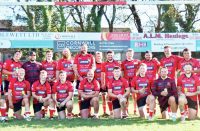Brendan Gallagher delves into some of rugby’s most enduring images, their story and why they are still so impactful

Iconic Rugby Pictures: PART 40
Uruguayan flight 571 crashes on Andes
Photo published December 12, 1972
What’s happening here?
It’s December 26, 1972 and the mindblowing story of Uruguayan Air Force Flight 571 and those who survived its crash high in the remotest part of the Andes is just beginning to break and shock the world.
This was the first image of the Fairchild FH-227D that had crashed on the remote Las Lasgrimas glacier to be sent around the world although the survivors had been picked up by helicopter three days earlier.
The crash involved the Old Christians rugby team and their supporters who had chartered the plane to Chile for a much anticipated weekend tour to Santiago, a trip which ended in the death of 29 members of their party and a savage fight for survival for the other 16.
Ultimately to prevail, the survivors had little option but to eat the human flesh of dead teammates and friends. In front of the plane is the body of one of those who perished, perfectly preserved by the fridge freezer temperatures.
The story behind the picture?
The Old Christians was a fun-loving club based exclusively around old boys of the Stella Maris catholic college, which was run by rugby mad Irish priests.
As rugby players they were decent by Uruguayan standards – Robert Canessa was selected to tour South Africa with Hugo Porta’s South American Jaguars in 1980 – but as individuals they were exceptional.
They were Uruguay’s future elite – young trainee lawyers, doctors, dentists, vets, surgeons, economists and entrepreneurs.
En route to Santiago from Montevideo there were reports of bad weather high in the Andes so their plane put down on the eastern – Argentinian – side of the Andes at Mendoza for the night. An evening of wine, fine dining and a few high jinks followed. They were on tour.
The following morning – Friday the 13th of October – they took off again but in poor visibility the plane’s pilot and navigator missed a radar beacon, became disoriented and started flying up the narrow spine of the Andes rather than simply crossing them. Thinking they had crossed the high mountains, the pilot began to descend and they crashed into a jagged mountain ridge. The tail part of the plane became detached and the large cigar shaped fuselage slid miles down an icy shallow valley.
What happened next?
Twelve of the party were killed instantly and another five died that first frozen first night high on the mountainside with most of those on the plane having only packed clothes for the warm weather anticipated in Santiago.
And so began the 72-day fight for survival. They had a few sweets and chocolates, some biscuits and cheese but no substantial food and almost nothing to drink.
They shaped some of the shattered fuselage to capture melted snow, the fixed awning to shelter them from the blistering midday sun and huddled together for warmth at night.
The medical students tended for the dying and then on the night of October 29 an avalanche buried the plane fuselage – their home where they were sleeping – and killed another eight who had fought so hard to survive to that point.
Having strayed so far of course, the rescue planes were looking in the wrong areas and eventually the Old Christians – deteriorating rapidly – realised they would have to effect the rescue themselves.
Midway through their torture with no other food source they had, with the greatest reluctance, taken the decision to exhume some of the bodies they had buried.
The two strongest of the survivors – Canessa and powerful lock Nando Parado – who had been in a coma for the first three days, the freezing cold helping to reduce the massive swelling in his skull – set out on a miraculous ten-day hike out of the glacier and over a 16,0000ft peak before they eventually dropped into a green valley in Chile.
There they were spotted by Sergio Catlan, a humble Chilean mulepacker who later returned with mules and food to help them back to a small outpost called Punte Negro from where the rescue was launched on December 23.
The survivors finally made it back on Christmas Eve.
Why is the picture iconic?
Because this is a unique story of human bravery and this image is a stark reminder of what a sports team overcame to prevail. It’s a monument to human endurance and the power of teamwork to overcome impossible odds.
All of the survivors agreed that no matter how hopeless the situation it was the natural trust, co-operation and camaraderie that every rugby team shares that got them through. Everybody – the strong, the weak, injured and, yes, even the dead – had roles to play that could make survival possible in the most testing of circumstances.
Multinationals around the world still ask Parado and Canessa to address their employees on the subect of teamwork and perseverance. Both have also written bestselling books, on the tragedy, telling how some of the team survived against the odds.
Footnote: Rather than destroy the club, the Andes tragedy strengthened the resolve of the Old Christians. Uruguay champions just twice before 1972 they have won the title on 18 subsequent occasions including in 1973, just nine months after the crash in the Andes.
























Pingback: Buy Colt Combat Unit Rail (9mm) Online